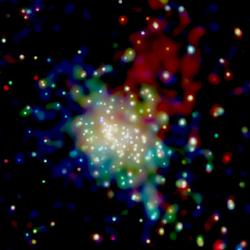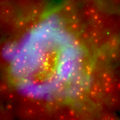December 18, 2002
RELEASE: 02-251
A mysterious cloud of high-energy electrons enveloping a young cluster of stars has been discovered by astronomers using NASA's Chandra X-ray Observatory. These extremely high-energy particles could cause dramatic changes in the chemistry of the disks that will eventually form planets around stars in the cluster.
Known as RCW 38, the star cluster covers a region about 5 light years across. It contains thousands of stars formed less than a million years ago and appears to be forming new stars even today. The crowded environment of a star cluster is thought to be conducive to the production of hot gas, but not high-energy particles. Such particles are typically produced by exploding stars, or in the strong magnetic fields around neutron stars or black holes, none of which is evident in RCW 38.
"The RCW 38 observation doesn't agree with the conventional picture," said Scott Wolk of the Harvard-Smithsonian Center for Astrophysics in Cambridge, MA, lead author of an Astrophysical Journal Letters paper describing the Chandra observation. "The data show that somehow extremely high-energy electrons are being produced there, although it is not clear how."
Electrons accelerated to energies of trillions of volts are required to account for the observed X-ray spectrum of the gas cloud surrounding the ensemble of stars, which shows an excess of high-energy X-rays. As these electrons move in the magnetic field that threads the cluster, they produce X-rays.
One possible origin for the high-energy electrons is a previously undetected supernova that occurred in the cluster. Although direct evidence for the supernova could have faded away thousands of years ago, a shock wave or a rapidly rotating neutron star produced by the outburst could be acting in concert with stellar winds to produce the high-energy electrons.
"Regardless of the origin of the energetic electrons," said Wolk, "their presence would change the chemistry of proto-stellar disks in ways that could still be manifest billions of years later."
For example, in our own solar system, we find evidence of certain short-lived radioactive nuclides (Aluminum 26 being the most well known). This implies the existence of a high-energy process late in the evolution of our solar system. If our solar system was immersed for a time in a sea of energetic particles, this could explain the rare nuclides present in meteorites found on the Earth today.
RCW 38, at a distance of 6,000 light years from Earth, is one of the nearest star-forming regions with very young, hot stars. Other authors of the paper, which appeared in the 2002 December 1 issue of the Astrophysical Journal Letters, are Tyler Bourke, Randall Smith and Bradley Spitzbart of the Harvard-Smithsonian Center for Astrophysics, and Joao Alves of the European Southern Observatory in Garching, Germany.
NASA's Marshall Space Flight Center, Huntsville, Ala., manages the Chandra program for the Office of Space Science in Washington. TRW, Inc., Redondo Beach, Calif., is the prime contractor for the spacecraft. The Smithsonian's Chandra X-ray Center controls science and flight operations from Cambridge, Mass.
MEDIA CONTACTS
Don Savage, Public Affairs Office
NASA Headquarters, Washington D.C.
Phone: 202-358-1727
Steve Roy
Marshall Space Flight Center, Huntsville, AL
Phone: 256-544-6535
Megan Watzke
Chandra X-ray Observatory Center, CfA, Cambridge, MA
Phone: 617-496-7998
cxcpress@cfa.harvard.edu




